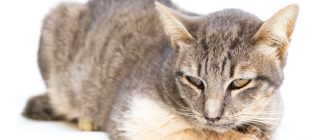Peritonitis in cats is called inflammation of the peritoneum – the membrane, lining the wall of the abdominal cavity that covers the internal animal organs. Such a disease takes the lives of cats on for 50 years. Even a physically strong animal that was affected by this disease, usually suffers and rarely can count on a favorable treatment outcome. Most exposed young individuals under the age of 2 years, as well as older individuals cats whose immune system cannot resist infection. Cats peritonitis cannot be transmitted to humans.
Causes of peritonitis in cats
Contents
Viral peritonitis, also called infectious, is caused FIPV coronavirus, which enters the animal after contact with the feces of an infected cat by airborne droplets or from an infected mother cat to a kitten (this happens in rare cases). Most susceptible to disease are cats that live in unsanitary conditions, which are not monitored for health and cleanliness. Very often, animals that contain in large groups, for example, in nurseries, at exhibitions, chatting with a lot of domestic cats. Those cats that do not have free access to walks on the street or communicate exclusively with healthy animals, usually very rare pick up the virus. Viral peritonitis can develop exudative (wet) way when many blood vessels, the elasticity of which decreases sharply in the organs and tissues of the animal gets liquid (exudate). The exudative course of the disease takes place in acute form. Non-exudative (dry) form of peritonitis viral in cats develops due to lesion of fewer blood vessels when pyogranulomas form (chronic inflammation with the formation of granulomas – nodules in various tissues of the body cats). Dry peritonitis most often proceeds in a chronic form, its symptoms are mild for a long time, which makes it difficult diagnosis. Most often, the virus infects cats and cats, who have recently suffered stress. Also coronavirus more often causes peritonitis in pedigree animals, and some veterinarians note that in different breeds the virus can infect more (or smaller) number of individuals.
Symptoms of peritonitis in cats
Symptoms of wet and dry peritonitis can vary significantly apart from each other. The wet form of the disease almost always entails followed by the death of a cat. With a quick call to a specialist and If wet peritonitis is diagnosed, it may turn dry if timely treatment and removal of exudate from the abdominal cavities of a cat. Exudative form:
- Accumulation of fluid in the abdominal cavity (ascites);
- Swelling of the lymph nodes and liver of the animal;
- Refusal of food (anorexia);
- Animal depletion (with a marked increase in the abdomen in volume);
- Difficulty breathing;
- Violation of the work of internal organs (liver, kidneys, pancreas) and the appearance in this regard characteristic symptoms
- Fever;
- Cramps.
Non-exudative form:
- Lack of appetite and weight loss cats;
- Inflammatory eye diseases;
- Damage to the central nervous system, which manifests itself in the form changes in animal behavior, impaired coordination, urinary incontinence, cramps.
- Intestine damage (enlarged colon wall), liver (jaundice, increase in size), kidney (education piogranulem).
Diagnosis and treatment of peritonitis in cats
The doctor listens to the owner of the cat, recognizing alarming symptoms. The diagnosis is made by a veterinarian based on a biopsy and tissue histology an animal that has been affected. Also in clinical conditions, effusion studies are performed (with exudative form), serological tests and histopathology of tissues affected by the disease. Based on such complex studies, the doctor makes a diagnosis and prescribes treatment. With a wet form of the disease, the veterinarian takes measures to remove accumulated fluid in the abdomen of a cat. IN depending on the symptoms of the disease and the condition of the animal, by the doctor antibiotics, immunosuppressants and immunostimulants are prescribed. Symptomatic therapy is also prescribed to help combat disturbances in the work of internal organs. Exudative form carries away the animal’s life in a few days, but with the right one treatment can give a cat a month of life after going to the doctor. The dry form allows the cat to stretch for about a year. Only in some cases when the virus did not manage to infect the cat’s organs very strongly, treatment was started immediately, the animal appears small chance for healing.






